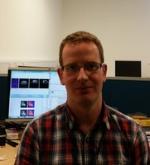Michael Kelly
Abstract:
The use of state-of-the-art preclinical imaging modalities to enhance in-vivo preclinical research at the University of Leicester
The Preclinical Imaging Facility at the University of Leicester was installed in 2013 as a result of a major infrastructural investment by the Wellcome Trust and the University. The facility is comprised of four state-of-the-art imaging systems: high field magnetic resonance imaging (MRI), high-frequency ultrasound, in-vivo fluorescence and bioluminescence imaging and micro-computed tomography (CT). In this talk, Dr Kelly will highlight the use of these imaging systems to enhance the quality and validity of in-vivo preclinical research, and to promote the application of the 3Rs of animal research. Data will be presented from exemplar studies using each of the four imaging systems:
MRI: Characterisation of the ischaemic stroke lesion following middle cerebral artery occlusion (MCAO) in mice, with the aim of reducing lesion volume variability and thereby increasing the utility of MCAO for the assessment of novel treatment strategies for stroke. Project Lead: Prof Claire Gibson, Dept. of Neuroscience, Psychology and Behaviour.
Ultrasound: Quantification of arterial distensibility from B-mode ultrasound images of the abdominal aorta in a mouse model of abdominal aortic aneurysm. Project Lead: Prof Dave Lambert, Dept. of Cardiovascular Science.
Bioluminescence Imaging: Development of a novel bioluminescent streptococcus pneumonia mouse strain for longitudinal assessment of pneumococcus infection. Project Lead: Dr Hasan Yesilkaya, Dept. of Infection, Immunity and Inflammation.
Micro-CT: Quantification of tumour burden in LSL-G12DKRAS mice by micro-CT imaging in order to link malignancy progression in-vivo with changes in the profile of circulating free DNA. Project Lead: Dr Miguel Martins, MRC Toxicology Unit.
Biography:
Dr Kelly is manager of the Preclinical Imaging Facility, University of Leicester, where he oversees the operation of four state-of-the-art, in-vivo imaging systems: high-field MRI, high-resolution ultrasound, micro-CT and bioluminescence/fluorescence imaging.
His current research interest involves the application of blood flow and diffusion-weighted MRI techniques to study the alterations that occur in the brain due to a variety of physiological and pathophysiological conditions such as increased neuronal activity, normal ageing, ischaemic stroke and hypertension.


















